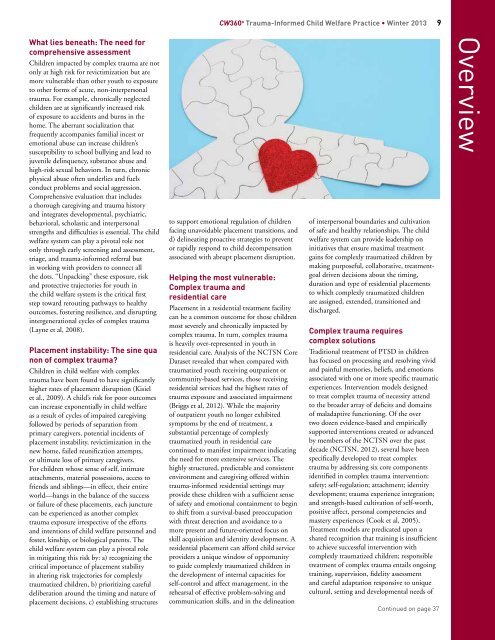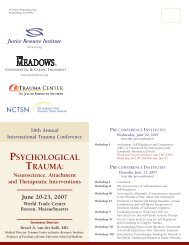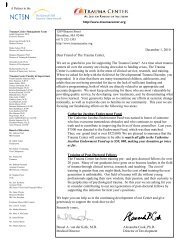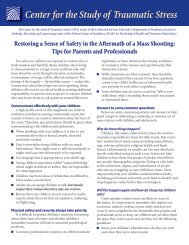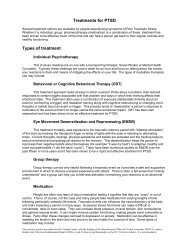in Child Welfare - The Trauma Center
in Child Welfare - The Trauma Center
in Child Welfare - The Trauma Center
Create successful ePaper yourself
Turn your PDF publications into a flip-book with our unique Google optimized e-Paper software.
CW360 o <strong>Trauma</strong>-Informed <strong>Child</strong> <strong>Welfare</strong> Practice • W<strong>in</strong>ter 2013 9What lies beneath: <strong>The</strong> need forcomprehensive assessment<strong>Child</strong>ren impacted by complex trauma are notonly at high risk for revictimization but aremore vulnerable than other youth to exposureto other forms of acute, non-<strong>in</strong>terpersonaltrauma. For example, chronically neglectedchildren are at significantly <strong>in</strong>creased riskof exposure to accidents and burns <strong>in</strong> thehome. <strong>The</strong> aberrant socialization thatfrequently accompanies familial <strong>in</strong>cest oremotional abuse can <strong>in</strong>crease children’ssusceptibility to school bully<strong>in</strong>g and lead tojuvenile del<strong>in</strong>quency, substance abuse andhigh-risk sexual behaviors. In turn, chronicphysical abuse often underlies and fuelsconduct problems and social aggression.Comprehensive evaluation that <strong>in</strong>cludesa thorough caregiv<strong>in</strong>g and trauma historyand <strong>in</strong>tegrates developmental, psychiatric,behavioral, scholastic and <strong>in</strong>terpersonalstrengths and difficulties is essential. <strong>The</strong> childwelfare system can play a pivotal role notonly through early screen<strong>in</strong>g and assessment,triage, and trauma-<strong>in</strong>formed referral but<strong>in</strong> work<strong>in</strong>g with providers to connect allthe dots. “Unpack<strong>in</strong>g” these exposure, riskand protective trajectories for youth <strong>in</strong>the child welfare system is the critical firststep toward rerout<strong>in</strong>g pathways to healthyoutcomes, foster<strong>in</strong>g resilience, and disrupt<strong>in</strong>g<strong>in</strong>tergenerational cycles of complex trauma(Layne et al, 2008).Placement <strong>in</strong>stability: <strong>The</strong> s<strong>in</strong>e quanon of complex trauma?<strong>Child</strong>ren <strong>in</strong> child welfare with complextrauma have been found to have significantlyhigher rates of placement disruption (Kisielet al., 2009). A child’s risk for poor outcomescan <strong>in</strong>crease exponentially <strong>in</strong> child welfareas a result of cycles of impaired caregiv<strong>in</strong>gfollowed by periods of separation fromprimary caregivers, potential <strong>in</strong>cidents ofplacement <strong>in</strong>stability, revictimization <strong>in</strong> thenew home, failed reunification attempts,or ultimate loss of primary caregivers.For children whose sense of self, <strong>in</strong>timateattachments, material possessions, access tofriends and sibl<strong>in</strong>gs—<strong>in</strong> effect, their entireworld—hangs <strong>in</strong> the balance of the successor failure of these placements, each juncturecan be experienced as another complextrauma exposure irrespective of the effortsand <strong>in</strong>tentions of child welfare personnel andfoster, k<strong>in</strong>ship, or biological parents. <strong>The</strong>child welfare system can play a pivotal role<strong>in</strong> mitigat<strong>in</strong>g this risk by: a) recogniz<strong>in</strong>g thecritical importance of placement stability<strong>in</strong> alter<strong>in</strong>g risk trajectories for complexlytraumatized children, b) prioritiz<strong>in</strong>g carefuldeliberation around the tim<strong>in</strong>g and nature ofplacement decisions, c) establish<strong>in</strong>g structuresto support emotional regulation of childrenfac<strong>in</strong>g unavoidable placement transitions, andd) del<strong>in</strong>eat<strong>in</strong>g proactive strategies to preventor rapidly respond to child decompensationassociated with abrupt placement disruption.Help<strong>in</strong>g the most vulnerable:Complex trauma andresidential carePlacement <strong>in</strong> a residential treatment facilitycan be a common outcome for those childrenmost severely and chronically impacted bycomplex trauma. In turn, complex traumais heavily over-represented <strong>in</strong> youth <strong>in</strong>residential care. Analysis of the NCTSN CoreDataset revealed that when compared withtraumatized youth receiv<strong>in</strong>g outpatient orcommunity-based services, those receiv<strong>in</strong>gresidential services had the highest rates oftrauma exposure and associated impairment(Briggs et al, 2012). While the majorityof outpatient youth no longer exhibitedsymptoms by the end of treatment, asubstantial percentage of complexlytraumatized youth <strong>in</strong> residential carecont<strong>in</strong>ued to manifest impairment <strong>in</strong>dicat<strong>in</strong>gthe need for more extensive services. <strong>The</strong>highly structured, predictable and consistentenvironment and caregiv<strong>in</strong>g offered with<strong>in</strong>trauma-<strong>in</strong>formed residential sett<strong>in</strong>gs mayprovide these children with a sufficient senseof safety and emotional conta<strong>in</strong>ment to beg<strong>in</strong>to shift from a survival-based preoccupationwith threat detection and avoidance to amore present and future-oriented focus onskill acquisition and identity development. Aresidential placement can afford child serviceproviders a unique w<strong>in</strong>dow of opportunityto guide complexly traumatized children <strong>in</strong>the development of <strong>in</strong>ternal capacities forself-control and affect management, <strong>in</strong> therehearsal of effective problem-solv<strong>in</strong>g andcommunication skills, and <strong>in</strong> the del<strong>in</strong>eationof <strong>in</strong>terpersonal boundaries and cultivationof safe and healthy relationships. <strong>The</strong> childwelfare system can provide leadership on<strong>in</strong>itiatives that ensure maximal treatmentga<strong>in</strong>s for complexly traumatized children bymak<strong>in</strong>g purposeful, collaborative, treatmentgoaldriven decisions about the tim<strong>in</strong>g,duration and type of residential placementsto which complexly traumatized childrenare assigned, extended, transitioned anddischarged.Complex trauma requirescomplex solutionsTraditional treatment of PTSD <strong>in</strong> childrenhas focused on process<strong>in</strong>g and resolv<strong>in</strong>g vividand pa<strong>in</strong>ful memories, beliefs, and emotionsassociated with one or more specific traumaticexperiences. Intervention models designedto treat complex trauma of necessity attendto the broader array of deficits and doma<strong>in</strong>sof maladaptive function<strong>in</strong>g. Of the overtwo dozen evidence-based and empiricallysupported <strong>in</strong>terventions created or advancedby members of the NCTSN over the pastdecade (NCTSN, 2012), several have beenspecifically developed to treat complextrauma by address<strong>in</strong>g six core componentsidentified <strong>in</strong> complex trauma <strong>in</strong>tervention:safety; self-regulation; attachment; identitydevelopment; trauma experience <strong>in</strong>tegration;and strength-based cultivation of self-worth,positive affect, personal competencies andmastery experiences (Cook et al, 2005).Treatment models are predicated upon ashared recognition that tra<strong>in</strong><strong>in</strong>g is <strong>in</strong>sufficientto achieve successful <strong>in</strong>tervention withcomplexly traumatized children; responsibletreatment of complex trauma entails ongo<strong>in</strong>gtra<strong>in</strong><strong>in</strong>g, supervision, fidelity assessmentand careful adaptation responsive to uniquecultural, sett<strong>in</strong>g and developmental needs ofCont<strong>in</strong>ued on page 37Overview


